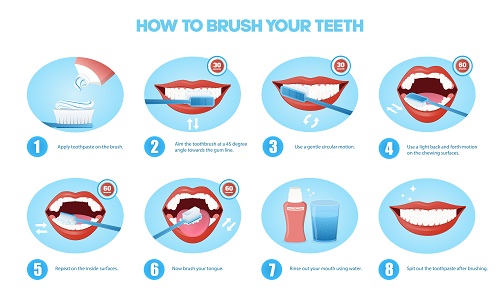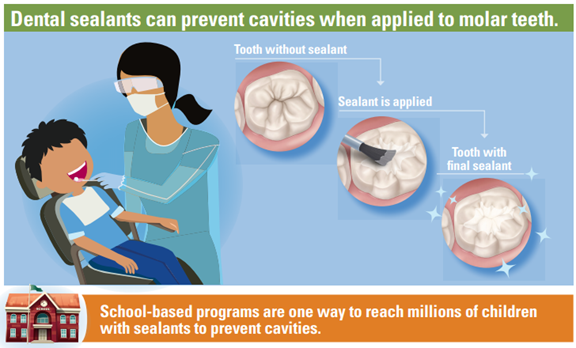According to the Centers for Disease Control and Prevention, cavities (also known as caries or tooth decay) are one of the most common chronic diseases of childhood in the United States. Untreated cavities can cause pain and infections that may lead to problems with eating, speaking, playing, and learning. Children who have poor oral health often miss more school and receive lower grades than children who don’t.
- North Dakota Oral Health: Pre-Kindergarten | This infographic provides oral hygiene tips for children pre-kindergarten age.
- Dental Sealants | This infographic illustrates why dental sealants are important for children’s oral health.
- Indigenous Teen Dental Habits to Promote Social, Physical, and Mental Health | This infographic provides oral health hygiene tips for students in middle and high school.
- Protecting the Smiles of our Indigenous Children | This infographic provides oral health hygiene tips for students in grades K-5.
- Video: Right amount of toothpaste
- Video: Toothbrush storage
- Video: Your toothbrush is calling!
- Video: A Toothbrush for every season

Good Oral Hygiene: Brushing and Flossing
Clean baby’s gums and begin brushing at first tooth eruption. Begin flossing as soon as two teeth touch. As children age, make sure they learn and practice good oral hygiene:
- Brush twice a day, for two minutes each time.
- Starting at age two, use toothpaste that includes fluoride.
- Help your child brush up until age eight.
- Make sure your child only uses a pea-sized amount of toothpaste and always spits it out rather than swallows it.
- Floss at least one time per day.
- Teach children healthy eating habits.
- Reduce sugary drinks and foods.
Your child’s chance of getting cavities can be higher if:
- Family members (older brothers, sisters, or parents) have cavities.
- They eat and drink a lot of sugary foods and drinks, like soda, especially between meals.
- They have special health care needs.
- They wear braces or orthodontics or oral appliances.
If any of these apply to your child, be sure to talk with your dentist, pediatrician, or family doctor to make sure you are taking extra steps to protect your child’s teeth.
Regular Dental Visits
The American Academy of Pediatric Dentistry recommends scheduling regular dental checkups, with the most common interval being every six months. However, the dentist might recommend fewer or more-frequent visits depending on your child's risk factors for oral health problems.
Dental Sealants
Dental sealants are thin coatings that when painted on the chewing surfaces of the back teeth (molars) can prevent cavities (tooth decay) for many years. Sealants protect the chewing surfaces from cavities by covering them with a protective shield that blocks out germs and food. Once applied, sealants protect against 80% of cavities for two years and continue to protect against 50% of cavities for up to four years. They can be applies as soon as permanent molars come into the mouth (typically around age six).
- Learn more about Dental Sealants form the Centers for Disease Control and Prevention
- Learn more about the North Dakota School-based Fluoride Varnish and Dental Sealant Program

Image provided courtesy of the Centers for Disease Control and Prevention at cdc.gov/oralhealth/publications/docs/Prevent-Cavities-infographic.pdf
FluorideVarnish
Fluoride varnish is a topical fluoride that helps prevent the teeth from cavities and can prevent the need for dental fillings. If cavities are in the early stages, the fluoride can slow or even stop the cavity process which can save time, money and the discomfort that is sometimes associated with a filling. Fluoride varnish is a protective coating that is painted on the teeth to help prevent cavities and to help slow or stop cavities that have just started. The entire process is fast, painless and takes less than five minutes to apply. Fluoride varnish can also be applied in primary care settings by other medical professionals.
- Access helpful infographics and learn more about Fluoride Varnish and other Fluoride Products from the Centers for Disease Control and Prevention.
Orthodontics
t's a good idea to get an orthodontic evaluation by the time a child is seven years old. Most dental providers will evaluate your child’s teeth at their normal preventive visits, and will make a recommendation as to when you should see an orthodontist. An orthodontist is a dentist with additional training, who specializes in aligning and straightening teeth. The best time for your child to get dental braces depends on the severity and the cause of the misalignment of your child's teeth.
Crooked teeth, overbites and underbites are best corrected with braces during puberty, while the facial bones are still growing. These are usually inherited traits, although some orthodontic problems stem from injuries, years of thumb-sucking or losing one’s baby teeth earlier or later than normal.
Traditionally, treatment with dental braces begins when a child has lost most of his or her baby (primary) teeth, and a majority of the adult (permanent) teeth have grown in — usually between the ages of 8 and 14.
Learn more about Dental Health and Orthodontic Problems from the American Academy of Pediatrics.
